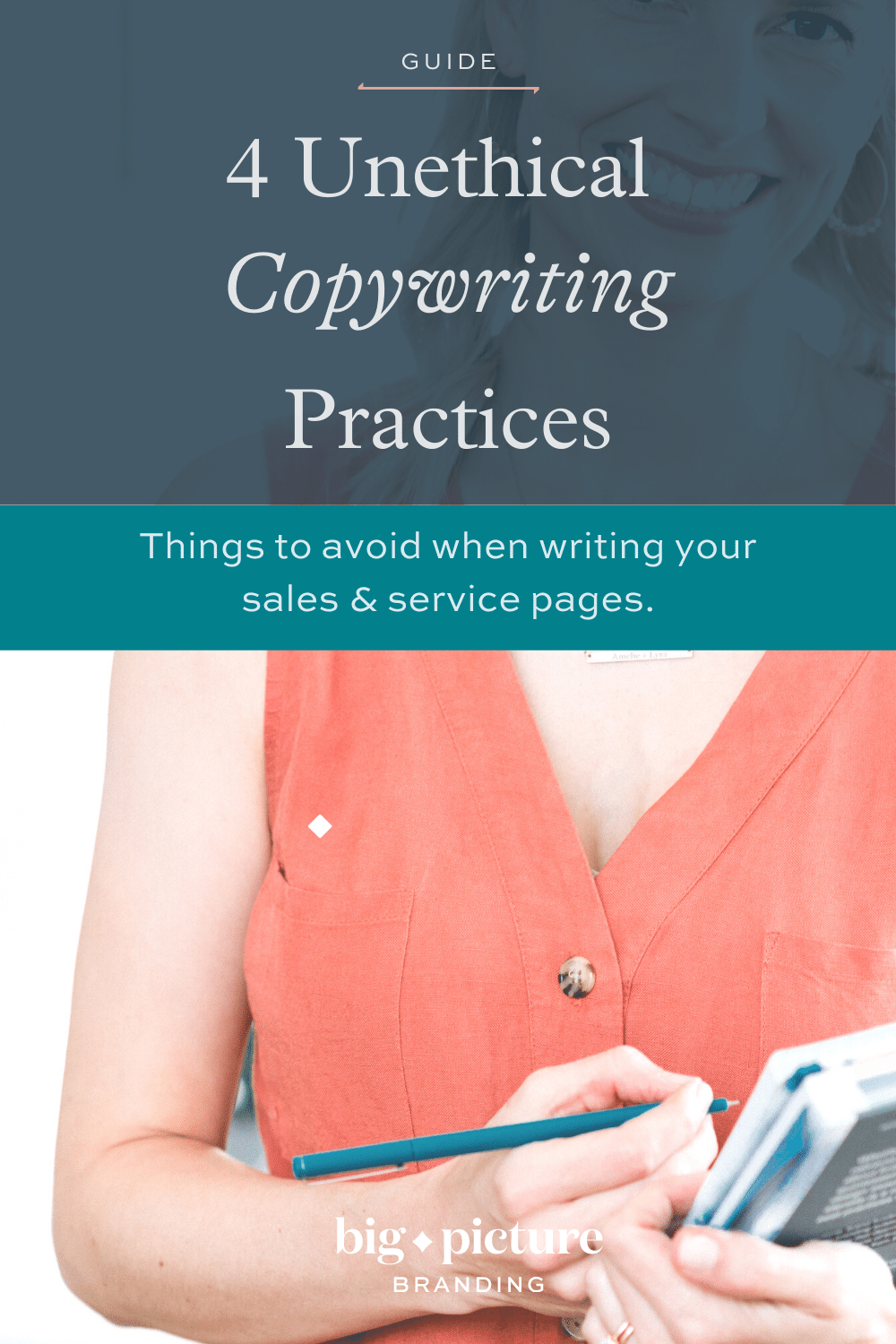The goal of most copywriting is pretty straightforward — connect with your audience. You want to offer up your products or services by telling your brand story in an authentic and compelling way.
If you stick to the facts and focus on how your experience, perspective, and skills can honestly help your audience achieve one of their goals, you’re using your powers of persuasion for good.
But sales copy…well that’s where I see both practiced marketers and DIY creative entrepreneurs fall down the slippery slope of unethical copywriting practices and sales tactics.
And I get it. The key to writing anything worth reading is to understand the psychology of your reader.
😬 But where copywriters and marketers get a bad rap is when they use our psychology against our best interests in order to sell us something we don’t need.
This is unethical and leads to some pretty cringeworthy, used-car-salesman, bait-and-switch copy that feels icky to read, and quite frankly, sucks to write.
The good news is, as a purpose-driven creative entrepreneur, your work is already rooted in positive intent. Good copywriting should be the simple act of putting your passion into words in order to relay the message that you can help/bring joy/educate those already looking for your products and services.
The bad news is, you might be practicing a few less-than-kosher sales tactics without even realizing it.
And you’ve definitely been the subject of many. (Have you ever wondered why so many course sales are $497? Read on, my friend…)
Here are 4 unethical copywriting practices to avoid when writing your services and sales page
1) Creating a false sense of urgency
Letting undecided prospects and customers know they have a finite amount of time to make a decision is perfectly fine if your reasons behind it are sound. For example, you may only be offering 10 spots in your program because that’s the number of people you feel you can manage to serve well at one time.
But, we’ve all seen fake countdown clocks on an evergreen course sales page and I have to wonder about those “there’s only 1 spot left!” or “only 2 left in stock!” announcements.
Now maybe you don’t want people to be disappointed when you run out of an item or to feel discouraged that they will have to wait a couple of months for your availability to open back up. That’s fair.
But if it becomes obvious that you’re using scare tactics to project scarcity, you’re already planting the seed in your audience’s mind that you’re not always transparent and honest in your business practices.
2) Vanity pricing
In full disclosure, I have experimented with my pricing to see if $x97 or $4xx resulted in more or fewer sales. (It made zero difference and made my quarterly financial estimates look like a math problem, so I just rounded up and haven’t seen a single drop in conversions.)
This tactic is called “the left-digit deficit.” It suggests that consumers don’t pay attention to the last digit of a price. Our brains focus on the first number in a price, making us feel like we’ve spent $400 on a $497 course instead of $500.
Making someone believe something is actually cheaper than it is, is playing dirty. Round up your prices (and price fairly) for a more ethical pricing strategy.
3) Dishonest testimonials
Editing your testimonials for grammar and length is legitimate. But taking your clients’ words out of context is not. Do not edit testimonials to the point of distortions and make sure your reviews correspond with the product or service on the page.
Have you ever gone online and realized the reviews for a toaster were actually for a printer? (I have and it wasn’t the first time it’s happened!)
Instead of “stretching” a review, go back and ask customers or clients for a review in exchange for a future discount or another incentive. A legitimate review is worth more than a fake one.
4) Jargon
I’ve written before that this has been my biggest challenge to date as someone who became a master of “Corporate Speak”. (Even though that’s not my true voice at all!)
Using jargon or big words to give the illusion of being important is not only a turn-off for almost everyone (even someone in your industry) it’s confusing!
Review your sales and marketing materials with a highlighter and take a step back to ask yourself if there is a way to say what you mean more simply. You don’t need to get rid of every industry term, only the ones that are posturing, misleading, or exaggerating a claim.
Here are 50 business jargon alternatives to keep on hand as a reference sheet when you’re writing. Print it out and stick it to your wall or save it to a “Resources” or “Swipe File” on your desktop for easy access.
TL;DR
At the end of the day, the gains you might make using unethical copywriting and sales tactics will never outweigh the price of an honest reputation. You don’t need strategic pricing or gimmicks if your messaging and copy is clear, concise, and compelling.
[P.S. Be sure to check out my post How To Write Ethical Sales Copy for more on this topic.]
PIN TO SAVE FOR LATER

